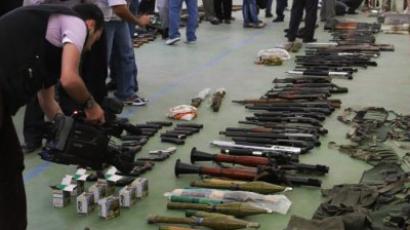The war of images - video of Syrian events, and their interpretation

The unrest engulfing Syria is mirrored in the internet with a PR-civil-war. While some videos show “atrocious bandits”, others opt for “atrocious army men”. And none shows what ordinary Syrians live through.
Unlike other countries of the Arab Spring, there are a lot of different videos about Syria on the internet. TV channels around the world broadcast selective videos of atrocities by armed men. At the same time, they fail to show millions of Syrians rallying to support the government. And they don’t show videos of atrocities against Syrian people.“The atrocity of bandits in this video is a sign that the US made a misjudgment,” Anhar Kochneva, director of the Jordan Club tourism organization comments on the video. “And now they are making an attempt of intimidating. It’s not a secret that they started preparing the anti-Syrian campaigns 10 years ago. They were proceeding from their understanding of Syrian people’s hatred toward the government, but they failed to notice that the country changed. They began supporting the anti-government rallies, but they failed to notice that these rallies actually brought people together. Millions of people just recently rallied in Aleppo, which the US considered an opposition center. The US believed that Syrians themselves would overthrow and betray Bashar al-Assad, but they failed to achieve an overturn performed by Syrians. Now they send in bandits, Syrians as well as those who co-operate with Americans among them. Some who got captured had performed terrible atrocities under the influence of drugs. For many of them, the only education they ever had was several years of school.”Kochneva believes that the US Security Force rules these atrocities of bandits:“Facebook didn’t work. They caused a provocation in Daraa but it didn’t work either. In the mid-April, the opposition met with Dan Feldman, representative of Hillary Clinton, in Istanbul. WikiLeaks reported that at that meeting a decision was made to start killing servicemen who at that time were unarmed, throughout the entire country. Four or 5 days later, servicemen in different parts of Syria were brutally murdered. And presently, many soldiers and officers are getting killed. Armed groups are kidnapping and murdering state officials.“There are two centers of unrest left, Homs and Idleb. These videos show fierce terror of Sthe summer of 2011 in these cities. Three thousand people were killed, a third of them servicemen, and a lot of state officials. Ninety per cent of these murders were performed by bandits. This is what happened recently: officials stopped for a coffee on their way somewhere, and they got murdered.“Bandits have been causing outrage in the north of the country, as there are many villages and forests there, which means a place for them to hide,” says Kochneva.
What’s the footwear of Syrian officers?
The Western media show videos of “atrocities of the Syrian army”. Kochneva comments on one of the most popular videos (of an officer beating up a boy): “Why is this officer wearing beach slippers?"“Unlike foreigners, the entire Syria knows what the army wears on their feet. In the area of Hama, an army uniform warehouse was robbed. Bandits wore these uniforms while looting and ransacking, and making videos of this kind. There was just one trouble – no boots at the warehouse. Therefore the officers in the video are wearing beach slippers. Moreover, after this robbery, the army was quickly transferred to a different type of uniform. Furthermore, how can anyone understand why officers would record their own dirt and post it in the internet? They aren’t even allowed to go home; when would they find time to spend at an internet café? The army has a high authority, and people really ask them to enter their settlements to protect them.”Kochneva is convinced that the West intentionally places a barrier for news from Syria. Otherwise, she believes, the EU and the US would not have imposed sanctions on the broadcast of Dunya, a Syrian TV channel which discusses videos of this kind of detail. Particularly, this channel even broadcasts the negotiations of the opposition. Some crafty migrants found a way of making voice chats discussing plans for destabilizing the country publicly available. Kochneva believes the authorities managed to take control over the country and to gain the support of the majority:“People are laughing already at conspirators and their instructors. A French ambassador who attempted to talk patriarch Ignatius into supporting the US had tomatoes and eggs thrown at him when he was taken outside. A US ambassador, who was watching a rally to support peace in Syria from his car window, got wrapped in a Syrian flag with Bashar al-Assad’s portrait on it. People are saying, ‘Yes, there was terror, it was frightening and confusing; but we’re no longer afraid of you.’”
How to create chaos
Russian political scientist Ruslan Kurbanov, who spent several years in the Islamic environment in Syria, agrees that there are no preconditions for a civil war; even though several years ago one would have thought that it was indeed possible to happen. According to his observations, unhappiness with the authorities was in the air as early as 2005. It was mainly expressed in rumors:“They said that people were disappearing. They were allegedly kidnapped by Mukhabarat for being unreliable. They said that kidnapped people were found several years later in prisons. They whispered about terrible conditions in Syrian prisons. I saw those who were personally affected by abuse of power. A family member of one of them was imprisoned for opposition-oriented statements; a relative of another one disappeared; a friend of yet another one went to Iraq, and now Mukhabarat examines his acquaintances. But this was just a tiny percentage of people.”There were also rumors of stopping armed people:“They said that armed people were stopped in Damascus. They stated those were militants. There were rumors about attacking and shooting between militants and the authorities,” says Kurbanov.But the official Syrian media did not respond to these rumors in any way, neither confirming nor denying them.Kurbanov notes the following characteristic episode:“Policemen in the street would not respond to the traditional greeting, ‘salam aleikum’. When I asked the locals why the police would not respond to my ‘salam’, I was told that all of the police are Alawis, and they do not like Sunnis, especially explicit ones.”
What is more likely to prevail: hatred toward the US, or tribal ideology?
According to Kurbanov, Syria’s Islamic circles have a strong feeling of resentment against the United States. People are very annoyed by the US trying to impose its standards on Syria, even with regard to modes of dress, and they are upset that the Syrian government agrees to adopt these standards.“For example, Syria’s authorities conceded to US demands and introduced tight pants for female students in high schools. There were also rumors about the US dictating to the Syrian government whether it should enroll foreign applicants in Islamic universities or not.”Kurbanov recalls that the US had once declared Syria part of the “Axis of Evil”, and many Syrians feared that the Americans would start bombing Syria the way they did to Iraq. However, Kurbanov believes the US quagmire in Iraq could have its own implication for Syria.“There were a lot of Syrians who volunteered to fight in Iraq. Bashar al-Assad rode this wave and agitated those who were spoiling for the fight. He let Syrians volunteers infiltrate Iraq. But those fighters were aware that after Iraq, they were to take on the regime back in Syria. I would not rule out that the lone gunners whom the Syrian government later had to hunt down at home were actually former insurgency fighters heading back from Iraq. In fact, it was not that difficult to creep over the border. I have heard stories about people from Syria easily slipping into Iraq, and even Afghanistan, and then coming back. I believe it is possible that some of Syria’s Iraq veterans jumped into the fight at home as soon as it started.”Kurbanov believes that the animosity and atrocities committed by the opposition as it can be seen from TV films is a manifestation of tribal psychology rather than of an Islamic or revolutionary one:“In my view, there was no soil for mutual hatred in society until the very last moment. But if blood was spilled in the first protests, I assume that the crowd might easily get filled with thirst to revenge the regime and separate soldiers. Even in the capital the Arabs have preserved their tribal mentality and are ready to stand up for their people.”Kurbanov believes that the abundance of false reels about the army atrocities has a political goal of causing chaos in the country and forcing Syria to break up its union with Iran.“I assume that these fakes are being injected into Syrian society to accelerate the speed of the explosion. Forces that are interested in this explosion want to break up Syria’s union with Iran. They include the United States, Saudi Arabia and Sunni Jihad fighters,” Kurbanov said.
Nadezhda Kevorkova, RT














